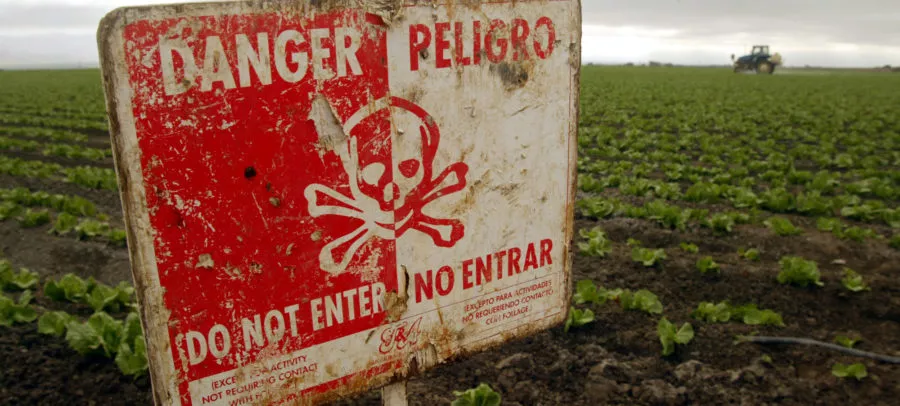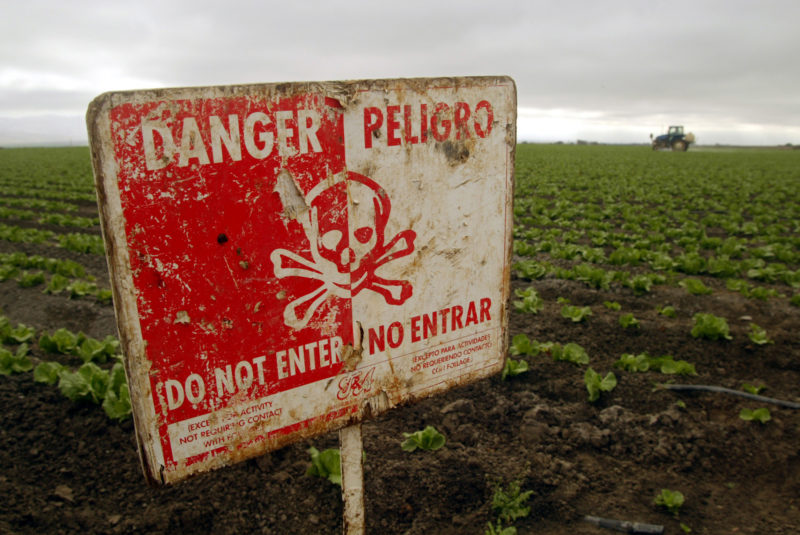 (AP Photo/Mike Fiala)
(AP Photo/Mike Fiala)
Driving through the streets of Salinas, Calif., teacher Oscar Ramos is never far from a field, or a school.
“Strawberries here,” he says, pointing through a car window to a plastic-covered expanse. “And that’s the middle school there,” he says, a beat later.
School, field. Field, school.
The combination is dangerous.
Salinas Valley is one of the most productive agricultural regions in the U.S.—nearly two-thirds of our lettuce is grown here and one-third of our strawberries. It also is home to tens of thousands of students, the vast majority of them Hispanic. Because of their proximity to the fields, these students risk frequent exposure to pesticides like chlorpyrifos, which is sprayed on crops even as numerous university studies have linked it to cognitive and health problems in children and Environmental Protection Agency (EPA) scientists have concluded it should be banned.
“Every year, I look at my incoming class list and it tells me, these certain kids have asthma, and these other ones have ADD or ADHD, and their numbers grow every year,” says Ramos, who, alongside other California Teachers Association members, has been raising the alarm about pesticides and their effects on students for years.
Recently, they achieved a small victory: a new rule from the California Department of Pesticide Regulation that bans pesticide spraying within a quarter-mile of schools, from 6 p.m. to 6 a.m. It’s a nod to the fact that pesticides endanger to students, but it doesn’t go nearly far enough, says Ramos, who is president of the local teachers’ union. Studies show pesticides have drifted as far as 2.9 miles, and they don’t evaporate with a snap of the fingers at 6 a.m.
Corporate profit has been judged more important than children’s health, Ramos says.
Salinas teacher Josh Ezekiel puts it this way: “We are Flint.”
Flint, of course, is the majority Black Michigan city whose water was poisoned with lead through the negligence of city officials, and whose families have been drinking and bathing their babies in bottled water since 2015. In both places—Flint and Salinas—residents may be poisoning themselves just by breathing the air, or drinking the water. Also, in both places, those risks are borne mostly by people of color.
“This is a flaring example of environmental racism,” says Lucia Calderon, an organizer with Safe Ag, Safe Schools, who works with Ramos, Ezekiel, and other Monterey County residents on pesticide-reform issues. “We have Flint in the news, Standing Rock in the news, but not a lot of people are talking about what is happening here in the Salinas Valley.”
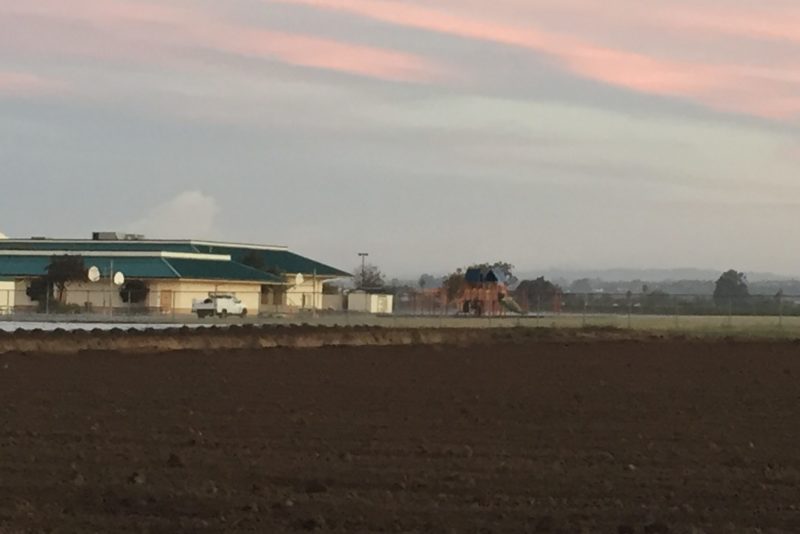 Many schools in the Salinas area are adjacent to agricultural fields, where growers commonly spray pesticides and fungicides. (Photo: Mary Ellen Flannery)
Many schools in the Salinas area are adjacent to agricultural fields, where growers commonly spray pesticides and fungicides. (Photo: Mary Ellen Flannery)
What is Environmental Racism?
The term includes the “deliberate targeting of communities of color for toxic waste facilities, the official sanctioning of the presence of life-threatening poisons and pollutants for communities of color, and the history of excluding people of color from leadership in the environmental movement,” writes former NAACP executive director, Ben Chavis, who was also an assistant to Dr. Martin Luther King Jr., and coined the term in 1984.
One of the first historic examples is Warren County, N.C., one of six counties in the state’s “Black Belt.” In 1979, after collecting 31,000 gallons of PCB-contaminated soil that had been illegally dumped by a local trucker across 14 North Carolina counties, and over the loud objections of Black residents and groups like the NAACP who feared groundwater contamination, the state chose Warren County—the county with the highest majority of Black residents—as the site to bury the toxic soil.
In California, Hispanic students are 91 percent more likely to attend schools with the highest exposure to agricultural pesticides
Their decision prompted the United Church of Christ Commission for Racial Justice (CRJ) in 1987 to study the makeup of communities near hazardous waste sites. Its study found that race—even when controlled for income and geography—was the most influential factor. Twenty years later, CRJ returned to the subject and found not much had changed: If you live near a hazardous waste facility, chances are you’re not White.
And it’s not just landfills. It’s exposure to lead, too. Between 1999 and 2004, Black children were three times more likely than White children to have lead in their blood at levels that cause permanent damage to their brains, according to the U.S. Centers of Disease Control (CDC).
People of color also are 38 percent more likely to breathe in polluted air—the kind that leads to asthma, heart disease, and cancer, a 2014 University of Minnesota study found. Again, race is key. Poor White people are more likely to have clean air than wealthy Hispanic people.
Meanwhile, in California, Hispanic students are 91 percent more likely to attend schools with the highest exposure to agricultural pesticides, a 2014 California Department of Public Health study found.
More recently, advocates also see environmental racism as a key factor in the disproportionate effects of climate change on indigenous people. From rising seas, to droughts in the Amazon basin, the effects of climate change endanger the lives of indigenous people in a way that they do not yet threaten the wealthier, Western, and White world.
Ironically, even as they suffer the most exposure, studies have found that people of color are least likely to contribute to pollution.
Have We Forgotten Flint?
In Warren County, N.C., Black residents eventually got some justice—environmental justice. After decades of suspected leaks, the state and EPA pledged $19 million in 1999 to de-toxify the landfill. Warren’s residents had held tenaciously to the goal of an onsite, permanent cleanup that would not foist their poisons on another community. Eventually, they got it.
Residents in Flint, on the other hand, are still pressing for fair treatment and clean water, says Jessyca Matthews, a Flint high school teacher and nominee for NEA Education Votes’ 2017 Social Justice Activist of the Year.
“Things have not changed dramatically in Flint. No, they’ve not,” says Matthews. It has been nearly four years since Flint residents could turn on their tap and safely drink what comes out, and local, state, and federal officials still don’t have a permanent solution.
Flint’s problems started when its profit-motivated managers—appointed by Republican Gov. Rick Snyder—decided in 2014 to stop buying water from Detroit, and siphon it from the more corrosive Flint River for an estimated savings of $8.5 million. Almost immediately, Flint residents could see and smell a difference. Eventually, a local pediatrician noticed an elevated level of lead poisoning in the city’s children.
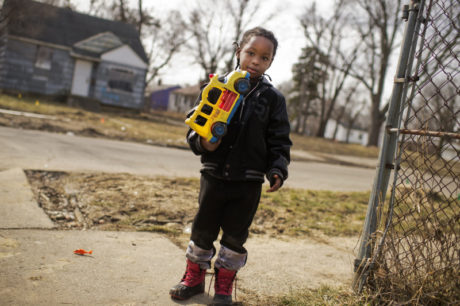 Families in Flint still can't be sure that their drinking water is safe.
Families in Flint still can't be sure that their drinking water is safe.
Today, the effects are becoming known. Since Flint changed its water, fetal deaths—pregnancies that lasted 20 weeks but did not result in births—have increased by 58 percent and fertility rates fallen by 12 percent, a recent study found.
No amount of lead is safe in children’s blood, experts say. At the highest levels, it can cause permanent damage to children’s brains, making it difficult for them to learn. A child who has been poisoned with lead is seven times more likely to drop out of school, and six times more likely to end up in the juvenile justice system, studies show.
So why hasn’t the world rushed to save Flint’s children? “It has to do with two things: race and money,” says Matthews. “It’s not just a Black issue because Flint is not all Black. But a large percentage of the people who live here are Black, and if this had happened in Ann Arbor or Royal Oak? We have to look at why the system isn’t working for communities of color.”
The Seeds of Justice
Back in Salinas, on a recent Thursday night, Ramos, Ezekiel, and other concerned citizens meet with organizer Calderon during their regular “Safe Ag, Safe Schools” meeting. After years of protesting and pressuring state officials, they have the new buffer zone. It is something, they agree, but nowhere near enough.
The science is irrefutable. Since 1999, UC Berkeley scientists have been following a group of nearly 800 children of primarily Latino farmworkers in Salinas, studying the effects of their exposure to pesticides, specifically organophosphates like chlorpyrifos, which were first developed as nerve-gas weapons during World War II. The study includes more than 150,000 biological samples—blood, urine, saliva, baby teeth, and hair.
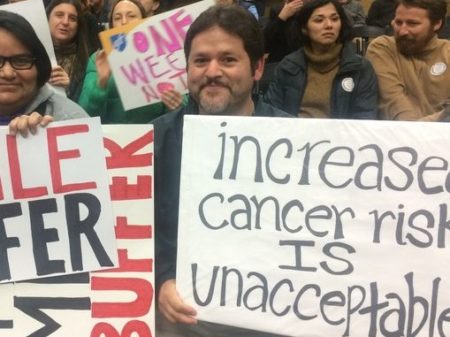 Salinas teacher Oscar Ramos at an anti-pesticide rally last summer.
Salinas teacher Oscar Ramos at an anti-pesticide rally last summer.
What they found is chilling. At age seven, the children with higher exposures scored seven points lower on IQ tests—the equivalent of being a half-year behind the others. They also found more likelihood of autism, attention disorders, and hyperactivity. Their brains actually look different in brain scans, with less volume in the areas associated with cognition and memory. Years later, those students were more likely to have dropped out of school.
All of this is apparent in classrooms, say Ramos, Ezekiel, and other members of the California Teachers Association, which is why educators have become the loudest voices in demanding change, says Calderon.
“Without the teachers working in these schools and seeing the problems of childhood cancers and learning disabilities firsthand, without them being able to advocate for their students, we wouldn’t be as successful as we’ve been,” she says.
Next, teachers want at least a mile-wide buffer zone, and at least 48-hours’ notice from growers before they apply pesticides or fumigants to fields near schools. Any agricultural commissioner in any California county can write more stringent rules—Imperial County has a one-mile-wide buffer zone, for example—and teachers are determined to make it happen. Lately, they have been holding informational meetings with parent groups.
“My favorite quote from Cesar Chavez is, ‘The fight is never about grapes or lettuce. The fight is always about the people,’” says Ezekiel. “We understand this is a business. We understand we need food. But it doesn’t have to come at the cost of our community. All we want is for them to find a way to grow more responsibly, to think about the health of the children.”
